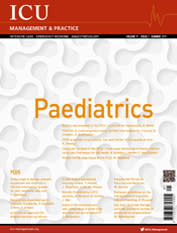Volume 19 - Issue 2, 2019
- ICU
- 30/05/2019
Change content default value
READ MORE
(I expert, I question, I answer) A selection from the ICU Management & Practice I-I-I blog. Have you got something to say? Visit https://healthmanagement.org/c/icu/list/blog or contact [email protected] Peter Pronovost Chief Clinical Transformation Officer - University Hospitals Cleveland, USA @PeterPronovost ...
READ MOREThis article describes the rise in PICU-acquired morbidities and its impact on patient outcomes. It discusses early rehabilitation strategies to improve patient outcomes in PICU. Introduction Critical care has traditionally been focused on early recognition of life-threatening conditions, resuscitation, and stabilisation of organ...
READ MOREFrom novel technology to family-centred care: new challenges for old needs Challenges and opportunities to improve care and practice in the PICU. “Martin, 2 years old. Sepsis and pneumoniae. High monitoring systems and modern therapies. A nurse is talking to his parents. A smile and a kind gesture help them in this overwhelming...
READ MOREPractical measures and interventions to reduce noise levels in the ICU and to improve the patient experience. The intensive care unit (ICU) is known to be noisy and is getting louder (Busch-Vishniac et al. 2007). Despite several trials, no interventions have been able to reduce noise levels by a meaningful amount (Li et al. 2011; Boyko...
READ MOREAs Personalised Medicine endeavours to discover more specific aetiologies and treatments of disease based on genetics and basic science research, it is crucial to maintain a focus on the patient-doctor relationship in order to more fully optimise patient care. In a world where the cutting edge is a crowded place, and people’s lives are at...
READ MOREInterview with Rolf Rossaint, Prof. of Anaesthesiology, RWTH University Aachen, Germany. Rolf Rossaint is a Professor and Chairman of the Department of Anaesthesiology of the University Hospital at the RWTH University Aachen, Germany. Prof. Rossaint has published several high-quality studies dealing with the treatment of severe acute respiratory...
READ MOREThe intensive care unit environment can be extremely stressful, even if they provide some of the best care in the world. It is believed that a patient in the ICU has their sleep interrupted approximately every three minutes either through noise, lights, or medical intervention. Up to 80% of patients in the ICU suffer from some form of delirium, and...
READ MOREResults of a study conducted by the University of Pittsburgh School of Medicine suggests that sepsis is not one condition, but many conditions that could benefit from different treatments. The findings are published in JAMA and were presented at the American Thoracic Society's Annual Meeting. Sepsis is the number one killer of hospitalised patients...
READ MOREDexmedetomidine is used to sedate patients while maintaining a certain degree of sustainability. The use of dexmedetomidine is known to reduce the duration of mechanical ventilation and delirium among patients in the intensive care unit (ICU). However, its use as the sole sedative agent in patients undergoing mechanical ventilation has not been studied...
READ MORE